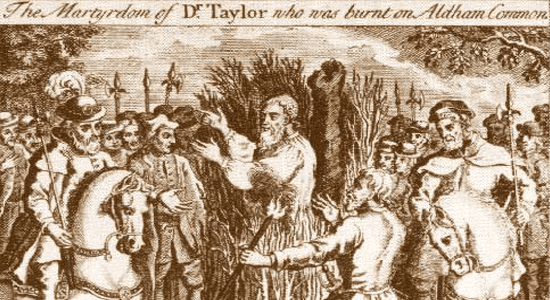
In this installment, we are going to start a series called Three British Martyrs. These were all martyrs under Bloody Mary and all of their martyrdoms and the accounts of their lives are recorded for us in Foxe’s Book of Martyrs.
The first British martyr to consider is Dr. Rowland Taylor. An inscription says about him, “In 1555, Dr. Taylor, in defending that which was good, at this place left his blood.” We also have this testimony to him left for us in Foxe’s Book of Martyrs:
“In this town of Hadleigh, Dr. Taylor was a good shepherd, abiding and dwelling among his sheep. He gave himself wholly to the study of Scripture, most faithfully endeavoring himself to fulfill that charge which the Lord gave unto Peter, saying, ‘Peter, do you love me? Feed my lambs’; ‘Feed my sheep’; ‘Feed my sheep.’ This love of Christ so wrought in him, that no Sunday nor holy day passed, nor other time, when he might get the people together, but he preached to them the Word of God, the doctrine of their salvation.”
Other than that, there is not a whole lot that we know about Rowland Taylor. We don’t know when he was born and we don’t know much about his schooling. He was a minister in the town of Hadleigh. It is thought that he was there for a long period of time. Some estimate that he was there for at least ten years of service. Hadleigh is a fascinating town; Thomas Bilney was a pastor there. Bilney was a significant figure in the British Reformation. And Bilney was able to sow many seeds there that, as Dr. Taylor came in as the minister, he was able to see the fruit.
We don’t have any of Taylor’s sermons. He never wrote a book. We do have a few letters. At one point, he wrote a letter to encourage some of his friends. This was while he was in prison. He writes,
“What will you have me to do? I am now old, and have already lived too long to see these terrible and most wicked days. Fly you, and do as your conscience leads you. I am fully determined, with God’s grace, to go to this Bishop, and to tell him to his beard that he doth naught. God shall well hereafter raise up teachers of His people, which shall with much more diligence and fruit teach them than I have done. For God will not forsake His Church, though now for a time He tries and corrects us, and not without just cause.”
The bishop to whose beard Taylor was going to speak was one of Mary’s bishops. Under Henry VIII and Edward VI, the gospel was flourishing in England, but when Mary I came to the throne, many faithful ministers of the gospel were rounded up and thrown into prison. Taylor was among them. For two years he sat in prison—we do know that. We also know that, as he said in his letter, he was an old man at that point. And we also know that he had nine children who survived him. He was in prison from 1553 to 1555, and in February 1555 he was led out and burned at the stake. J.C. Ryle, in his book commemorating some of these lives of the martyrs, speaks of Taylor as a pastor in a small town outside of London and says, “Such a position is fatal to a world-wide celebrity.”

So, as it stands, we don’t know much about Rowland Taylor. We do know that he gave his life in the cause of the gospel, that he was an unflinching martyr alongside other martyrs, in a trying time in the life of England. And we know, as that inscription says,
“In 1555, Dr. Taylor, in defending that which was good, at this place left his blood.”
He may not be a worldwide celebrity, but he was a martyr of the faith.
Stay connected with 5 Minutes in Church History by getting the weekly podcast on iTunes, SoundCloud, or via RSS. You can also subscribe to the blog via RSS and follow us on Twitter and Facebook.
(This podcast is by Ligonier Ministries. Discovered by e2 media network and our community — copyright is owned by the publisher, not e2 media network, and audio is streamed directly from their servers.)